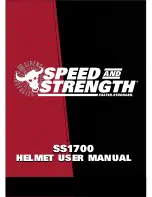
94
Adjustments for Competition
Front Suspension Adjustments
The front suspension can be adjusted for the
rider’s weight and riding conditions by using one
or more of the following methods:
•
Oil volume
— The effects of higher or lower
fork oil level are only felt during the final 3.9
in (100 mm) of fork travel.
•
Compression damping
— Turning the
compression damping screw adjusts how
quickly the fork compresses.
•
Rebound damping
— Turning the rebound
damping screw adjusts how quickly the fork
extends.
•
Fork springs
— Optional springs are
available in softer and stiffer types than the
standard rate. (page 147)
The inverted fork on your CRF features sealed
damper cartridges with dual (separate air and oil)
chambers to prevent aeration. The design also
isolates the oil in each fork tube/slider, which
may contain air bubbles and/or metal particles,
from the sealed cartridge to provide more
consistent damping.
(1) compression damping adjuster
(2) rebound damping adjuster
(1)
(2)
Front Suspension Air Pressure
Air is an unstable gas which builds up pressure
as it is worked (such as in a fork). Air pressure
acts as a progressive spring and affects the entire
range of fork travel. This means the fork action
on your CRF will get stiffer during a race. For
this reason, release built-up air pressure in the
fork legs between motos. Be sure the fork is
fully extended with the front tire off the ground
when you release the pressure.
The standard air pressure is 0 psi (0 kPa, 0
kgf/cm
2
). You may relieve accumulated air
pressure in the fork legs by using the pressure
release screws. The front wheel should be off the
ground before you release the pressure.The air
pressure should be adjusted according to the
altitude and outside temperature.
1. Place an optional workstand under the engine,
so that the front wheel is off the ground.
Do not adjust air pressure with the front wheel
on the ground as this will give false pressure
readings.
2. Remove the pressure release screw (1).
3. Check that the O-ring (2) is in good condition.
4. Install the pressure release screw to the
specified torque:
0.9 lbf·ft (1.2 N·m, 0.12 kgf·m)
(1) pressure release screws
(2) O-ring
(2)
(1)
Front Suspension Damping
Rebound Damping Adjustment
The fork rebound damping adjuster screw (1) has
16 positions or more. Turning the adjuster screw
one full turn clockwise advances the adjuster four
positions. To adjust the rebound damping to the
standard setting, proceed as follows:
Turn the adjuster clockwise until it will no longer
turn (lightly seats). This is the full hard position.
The adjuster is set in the standard position when
the adjuster is turned counterclockwise 8 clicks.
Make sure that both fork legs are adjusted to the
same position.
Compression Damping Adjustment
This adjustment affects how quickly the fork
compresses. The fork compression damping
adjuster screw (2) has 16 positions or more.
Turning the adjuster screw one full turn changes
the adjuster four positions. To adjust the adjuster
to the standard position, proceed as follows:
Turn the adjuster clockwise until it will no longer
turn (lightly seats). This is the full hard position.
The adjuster is set in the standard position when
the adjuster is turned counterclockwise 10 clicks.
Make sure that both fork legs are adjusted to the
same position.
Summary of Contents for CRF250R 2005
Page 1: ...2005 Honda CRF250R OWNER S MANUAL COMPETITION HANDBOOK ...
Page 14: ...10 Before Riding ...
Page 20: ...16 Basic Operating Instructions ...
Page 140: ...136 Tips ...
Page 153: ...Technical Information 149 Wiring Diagram THROTTLE POSITION SENSOR SPARK PLUG ...
Page 154: ...150 Technical Information ...
















































